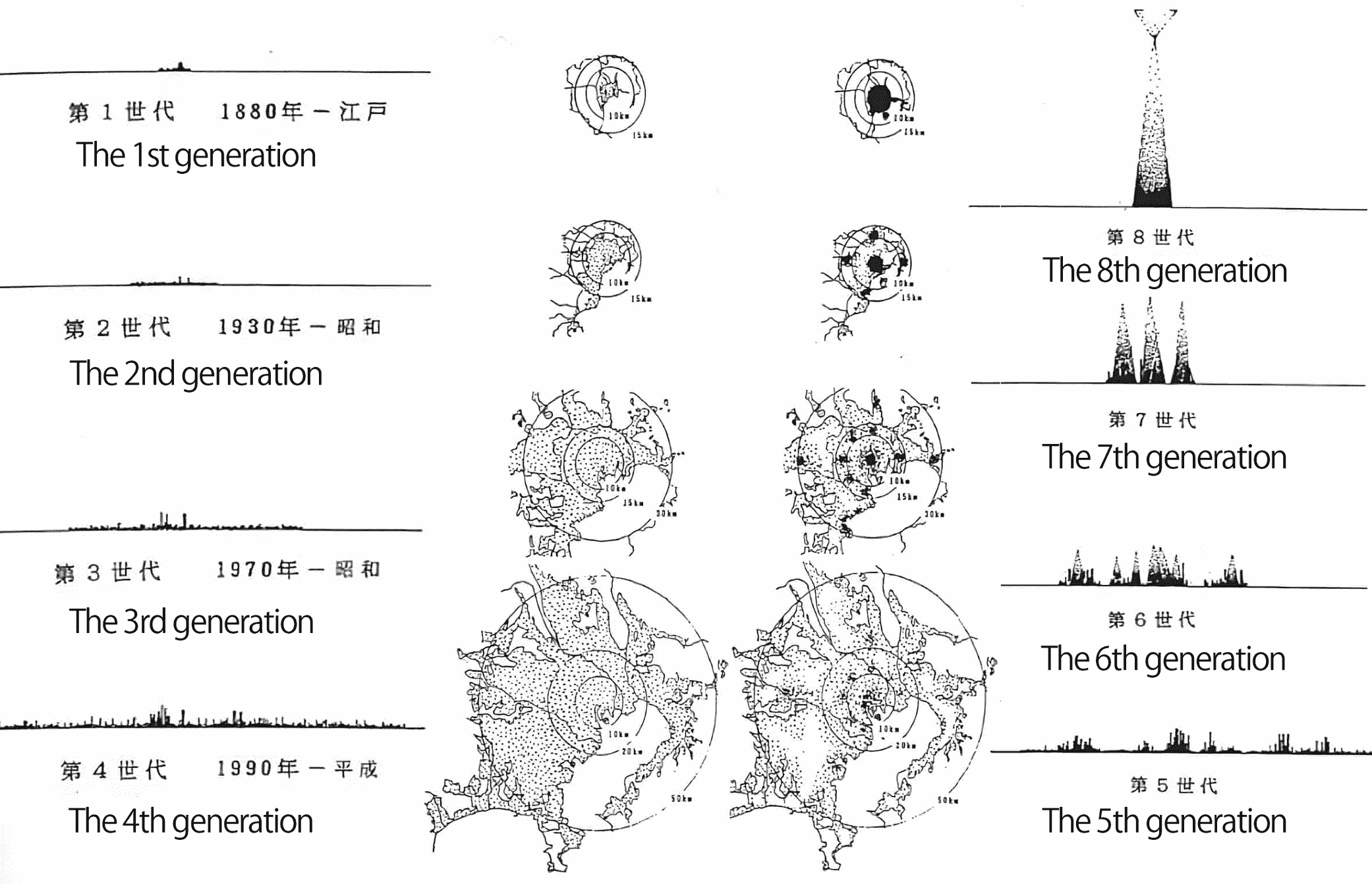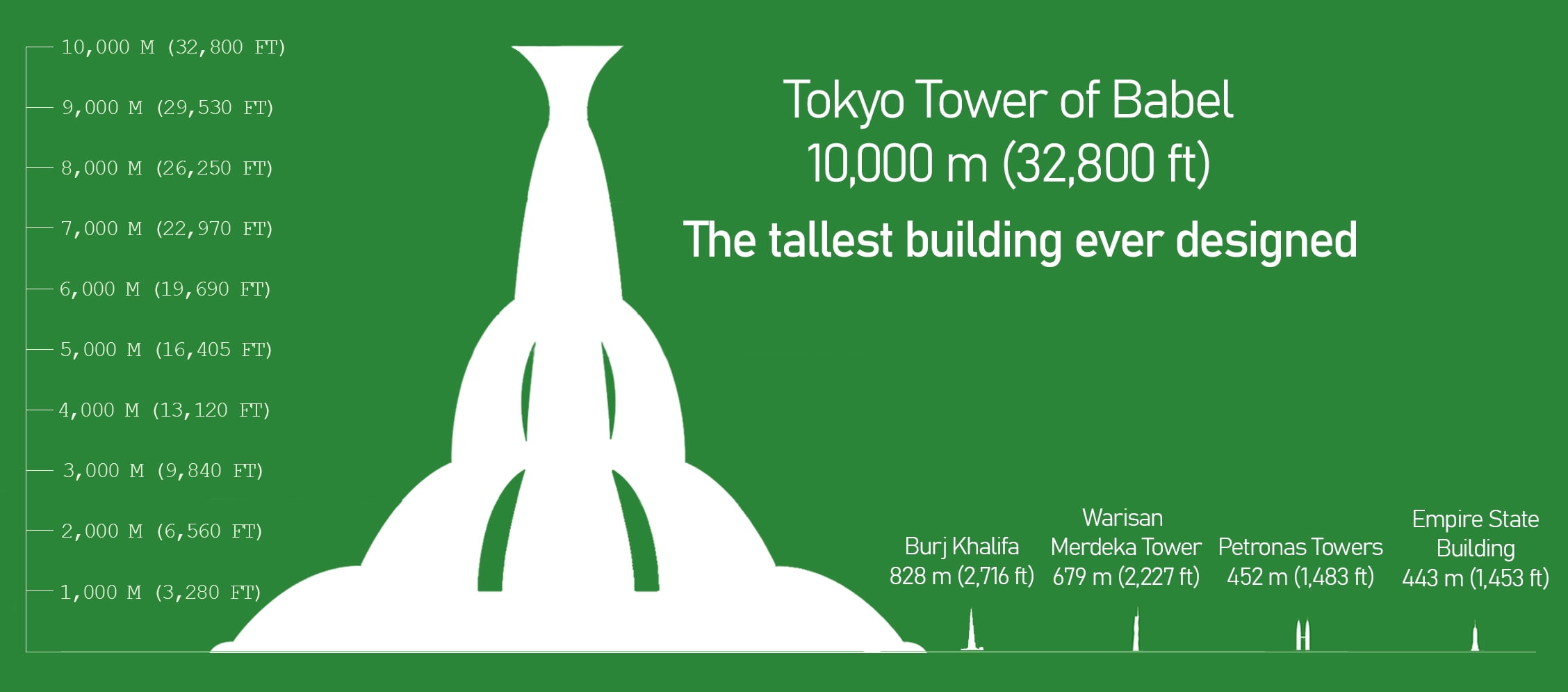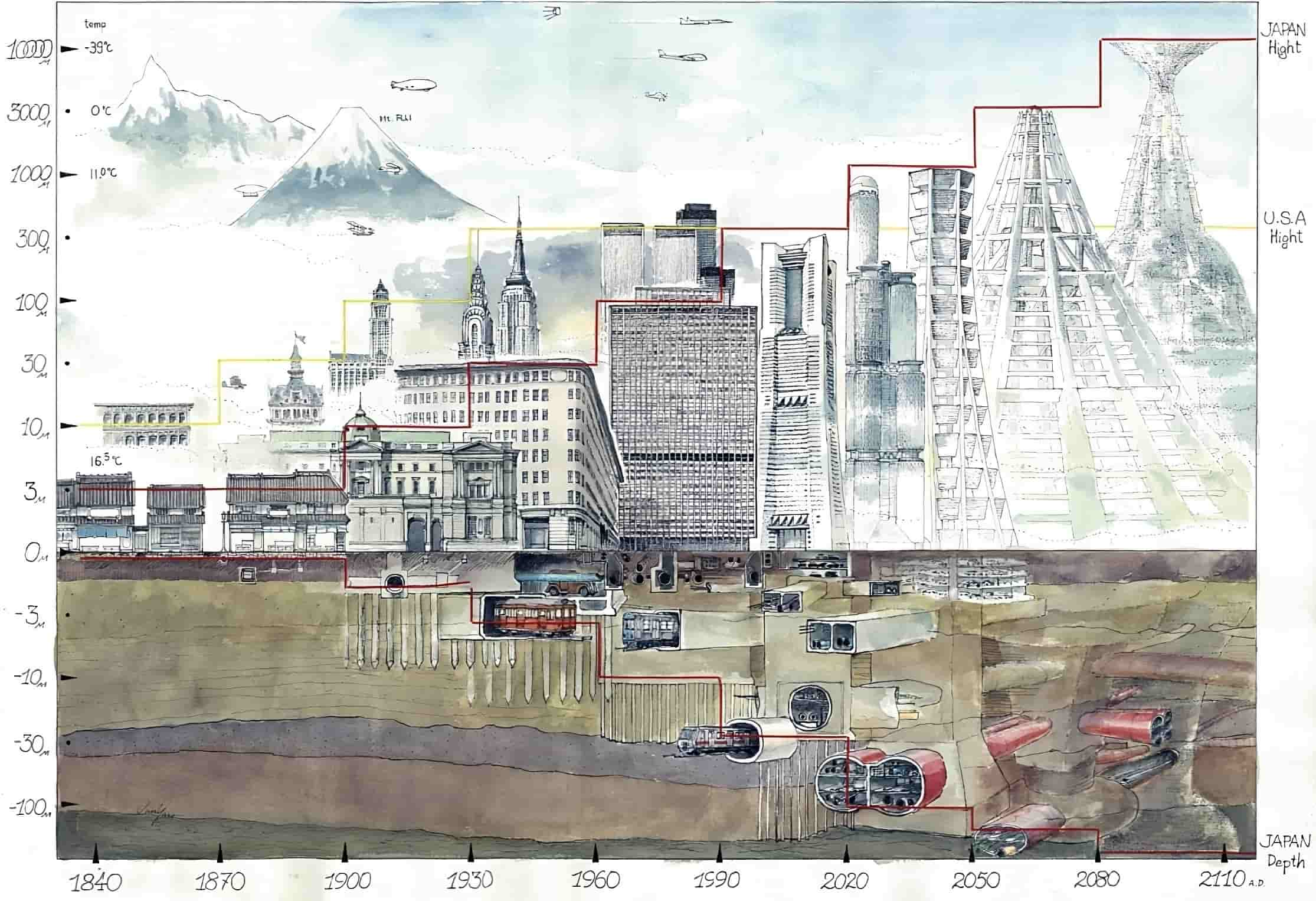The Tokyo Tower of Babel is a proposed hyperbuilding in the city of Tokyo that is 33,000 feet or 6,2 miles (10 km) tall. The Tokyo Tower of Babel was designed as a new megastructure by Professor Toshio Ojima of Waseda University. And it is the world’s tallest building ever envisioned by humankind. This ultra-skyscraper requires approximately 100 to 150 years to complete. But once built, it has the capacity to house 30 million people. The name alludes to the aspiration that it ascends to the heavens like the biblical Tower of Babel, which was 8,150 ft (2,500 m) tall. If built, the Tokyo Tower of Babel would reach a height that is 3,770 feet (1,150 m) higher than Mount Everest. This makes the project an unprecedented architectural achievement.
What is the Tokyo Tower of Babel?

The Tokyo Tower of Babel is an urban structure that is 33,000 feet (10,000 meters) in height. The building was proposed at the 1992 Brazil Earth Summit by the architect Toshio Ojima. At the time, it was one of many 1,000-meter-class eco-friendly ultra-high skyscrapers. These skyscrapers were designed by major construction corporations and developers in the 1980s and early 1990s. Among them, the Tokyo Tower of Babel is the tallest visionary skyscraper ever put forward.
The closest building in height to the Tokyo Tower of Babel would be the X-Seed 4000 which is only 13,100 feet (4,000 m) tall. X-Seed 4000 has 800 floors. But, the Tokyo Tower of Babel has around 1969 floors on average.
The structure’s logarithmic design, conical shape, wide base, and narrowing top parts make it strong enough to bear any force applied to it. The Tokyo Tower of Babel is an example of arcology because the project focuses on biodiversity preservation.

The growth of the Tokyo metropolitan area is split into eight different generations. It begins with the Edo period in 1880 and continues into the far future. In the final stage, or the 8th generation, all of the residents of the area will begin to live in a single megastructure, similar to the Tokyo Tower of Babel. This megastructure is designed to mitigate the negative environmental effects of urban growth.
In the 8th generation, this mega building or the Tokyo Tower of Babel begins housing 30 million residents. This hyperstructure is supposed to be located on the inner side of the Yamanote Line, one of Tokyo’s busiest lines that was opened in 1885. The blueprint and model of the building were based on the concept art of Masaki Yabuno.
The Purpose of the Project

Hyperbuilding projects like Japan’s Tokyo Tower of Babel propose verticalizing overpopulated metropolises. The aim is to address the issue of unorganized, flat urban buildings in Tokyo city. The megastructure brings together all of the city’s government, business, and recreation facilities into one huge building. Urban planners are working on a solution to the heat island effect of overpopulated cities for future generations. This effect is brought on by the buildup of waste heat from urban activities as well as other environmental issues. This includes vehicles’ exhaust emissions and access issues like traffic congestion.
After Japan’s economic bubble burst in 1994, the Japanese Hyper Building Study Group was formed to continue researching hyperstructures such as the Tokyo Tower of Babel. But the frequent changes in government and the frequent earthquakes were the last straw for this study group.
As a result, the Tokyo Tower of Babel was never constructed. As the Japanese economy collapsed, it seems that bold ideas like this were put on hold. Most of them failed to see the broader social and economic implications. Because they were too preoccupied with the technical possibilities of the moment. One of them was undoubtedly the Tokyo Tower of Babel.

At a height of 33,000 feet (10,000 m), the Tokyo Tower of Babel dwarfs even the biggest structures. This includes the Burj Khalifa (2,716 ft/828 m) and Everest (29,032 ft/8,849 m). If built, it would be without question the highest structure on the planet. For comparison, jet planes go no lower than 33,000 ft (10 km) on domestic flights and 39,000 ft (12 km) on international flights. At a height of 33,000 ft (10 km), the air pressure is one-fourth that at sea level, and the temperature is about -67 degrees Fahrenheit (-55 degrees Celsius).
The Cost of the Tokyo Tower of Babel
With a capacity of 30 million people, the Tokyo Tower of Babel is an enormous megastructure. The building’s construction cost is 25 trillion USD. It comes with a basal area of 42,5 mi2 (110 km2), a total floor area of 656 mi2 (1,700 km2, including all levels of floors) and an impressive steel volume of 10 billion tons. This total floor area is equal to the area of the city of Houston (4,460 mi2).
According to a 2010 estimation, building the Tokyo Tower of Babel would cost 3 quadrillion yen, or 3,3 quadrillion yen in 2023. This makes around 25 trillion USD in today’s money (or 25,500,000,000,000 US dollars). The structure was expected to cost about 30 years of Japan’s national budget, or six times the country’s GDP. This was solely because of how impractical and destructive the plan was. The megastructure was devised in the so-called booming era of the “bubble economy” in Japan, lasting from 1986 to 1991.
Tokyo Tower of Babel’s Design

The Tokyo Tower of Babel reaches all the way to 33,000 feet (10,000 m) in height. Thus, the overall design of this mega building is separated into several designations. They are divided into specific heights, and each of them provides specific functions.
| Territory | Facilities | Height | Area |
|---|---|---|---|
| Geo Territory | underground infrastructure, energy plants, parking lots, and generators | Underground | – |
| Human Territory | residential and commercial complexes | Up to 3,300 ft (1,000 m) | 250k ac (100k ha) |
| Cloud Territory | commercial, office, and hotel spaces | Up to 11,500 ft (3,500 m) | 75k ac (30k ha) |
| Sky Territory | educational, administrative, and leisure facilities | Up to 19,500 ft (6,000 m) | 50k ac (20k ha) |
| Ultimate Territory | industrial, experimental research, and base facilities | Up to 30,000 ft (9,000 m) | 50k ac (20k ha) |
| Space Territory | solar energy collector and a space development center. | Up to 33,000 ft (10,000 m) | 250k ac (100k ha) |
The Challenges to the Tokyo Tower of Babel

The Tower of Babel is designed to be environmentally friendly and energy efficient. In theory, large swaths of the Kanto Plain, the largest plain in Japan, would be made available as a result of the construction of this hyperbuilding. However, there are a few challenges to the Tokyo Tower of Babel project:
Extreme cost
First, the task of creating a budget for the proposed construction of the Tokyo Tower of Babel is challenging. This is due to the extreme cost of the project and the need for expensive, semi-permanent repairs. Relocating the residents and businesses in the area surrounding the tower would take a significant amount of time and money.
A large plot of land
To build the Tokyo Tower of Babel, you would also need a large piece of land with a minimum size of 10.5 km. This is for a square foundation. For a circle foundation, the minimum radius would be 6 km (12 km in diameter).
Restricted flight zone
When a building’s height exceeds 3,300 feet or 1,000 meters, the airspace around it will have to be restricted. This is due to the risk of aircraft collisions caused by man-made or unexpected difficulties, such as terrorism. In order to reduce the likelihood of accidents, flying would need to be closely regulated or outright forbidden in the area of the building.
Potential death toll
There is a potential death toll from the collapse of the Tokyo Tower of Babel caused by an earthquake or other disaster. And this could be in the tens of millions, particularly in earthquake-prone areas like the Tokyo metropolitan region. To avoid the loss of many lives in the event of a structural failure, the Tokyo Tower of Babel must meet extremely stringent safety standards.
Harsh weather conditions
Moving on, the inhabitable space on the upper floors of the Tokyo Tower of Babel would have to be as airtight and heat-retaining as a jet airliner. This is to protect the people inside from the harsh weather outside, such as broken windows, strong gusts of wind, and temperatures as low as -67°F or -55°C.
FAQ About the Tokyo Tower of Babel
Will the Tokyo Tower of Babel be built?
It’s quite doubtful that the Tokyo Tower of Babel will ever be constructed in the next 100 years. But if it were, it would be the highest building in the world, making Mount Everest seem like a toy by 3,770 feet (1,150 m).
How long would it take to build the Tokyo Tower of Babel?
The construction of this ultra-skyscraper is projected to take between 100 and 150 years. But once completed, it would be large enough to house 30 million people.
How high is the Tokyo Tower of Babel?
Professor Toshio Ojima proposed the Tokyo Tower of Babel in 1992, and it stands 33,000 feet (6.2 miles) or 10,000 meters tall.
How many floors does the Tokyo Tower of Babel have?
The Tokyo Tower of Babel has around 1969 floors on average. The structure is famous for its height.





